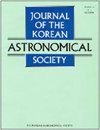MORPHOLOGY OF DWARF GALAXIES IN ISOLATED SATELLITE SYSTEMS
IF 0.8
4区 物理与天体物理
Q3 ASTRONOMY & ASTROPHYSICS
引用次数: 3
Abstract
The environmental dependence of the morphology of dwarf galaxies in isolated satellite systems is analyzed to understand the origin of the dwarf galaxy morphology using the visually classified morphological types of 5836 local galaxies with $z \lesssim 0.01$. We consider six sub-types of dwarf galaxies, dS0, dE, dE$_{bc}$, dSph, dE$_{blue}$, and dI, of which the first four sub-types are considered as early-type and the last two as late-type. The environmental parameters we consider are the projected distance from the host galaxy ($r_{p}$), local and global background densities, and the host morphology. The spatial distributions of dwarf satellites of early-type galaxies are much different from those of dwarf satellites of late-type galaxies, suggesting the host morphology combined with $r_{p}$ plays a decisive role on the morphology of the dwarf satellite galaxies. The local and global background densities play no significant role on the morphology of dwarfs in the satellite systems hosted by early-type galaxies. However, in the satellite system hosted by late-type galaxies, the global background densities of dE and dSph satellites are significantly different from those of dE$_{bc}$, dE$_{blue}$, and dI satellites. The blue-cored dwarf satellites (dE$_{bc}$) of early-type galaxies are likely to be located at $r_{p} > 0.3$ Mpc to keep their cold gas from the ram pressure stripping by the hot corona of early-type galaxies. The spatial distribution of dE$_{bc}$ satellites of early-type galaxies and their global background densities suggest that their cold gas is intergalactic material accreted before they fall into the satellite systems.孤立卫星系统中矮星系的形态
利用5836个局部星系的视觉分类形态类型$z \lesssim 0.01$,分析了孤立卫星系统中矮星系形态的环境依赖性,以了解矮星系形态的起源。我们考虑了矮星系dS0、dE、dE$ {bc}$、dSph、dE$ {blue}$和dI 6个子类型,其中前4个子类型认为是早型,后2个子类型认为是晚型。我们考虑的环境参数是与宿主星系的投影距离($r_{p}$)、局部和全局背景密度以及宿主形态。早型星系的矮卫星的空间分布与晚型星系的矮卫星有很大的不同,说明宿主形态与$r_{p}$的结合对矮卫星星系的形态起着决定性的作用。在由早期型星系承载的卫星系统中,局部和全局背景密度对矮星的形态没有显著影响。然而,在由晚型星系承载的卫星系统中,dE和dSph卫星的全球背景密度与dE$_{bc}$、dE$_{blue}$和dI卫星的全球背景密度有显著差异。早型星系的蓝核矮卫星(dE$_{bc}$)可能位于$r_{p} > 0.3$ Mpc,以防止它们的冷气体被早型星系的热日冕剥离。早期星系的dE$_{bc}$卫星的空间分布及其全球背景密度表明,它们的冷气体是在落入卫星系统之前被吸积的星系间物质。
本文章由计算机程序翻译,如有差异,请以英文原文为准。
求助全文
约1分钟内获得全文
求助全文
来源期刊

Journal of the Korean Astronomical Society
地学天文-天文与天体物理
CiteScore
1.30
自引率
10.00%
发文量
0
审稿时长
>12 weeks
期刊介绍:
JKAS is an international scientific journal publishing papers in all fields of astronomy and astrophysics. All manuscripts are subject to the scrutiny of referees. Manuscripts submitted to JKAS must comply with the ethics policy of JKAS. Six regular issues are published each year on February 28, April 30, June 30, August 31, October 31, and December 31. One year''s issues compose one volume.
 求助内容:
求助内容: 应助结果提醒方式:
应助结果提醒方式:


